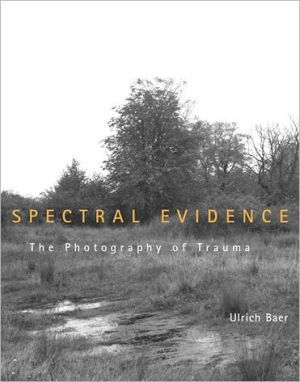

 |

|

The average rating for Spectral Evidence: The Photography of Trauma based on 2 reviews is 4 stars.
Review # 1 was written on 2012-11-06 00:00:00 Obiel Solis Zalapa Obiel Solis ZalapaThis book is suggestive rather than having a strong argument. The structure is a little eccentric: photographs of hysteria are analysed in one chapter, while the rest of the book considers photographs about the holocaust. There's little engagement with other books on the topic of holocaust imagery such as the work of Didi-Huberman, Lisa Saltzman and Barbie Zelizer. On the other hand, the book does raises some interesting issues about hysteria and the camera and examines some interesting photographic projects about the Holocaust. On the whole, the writer does not handle images well, although the discussion of landscape is quite nuanced. My feeling is the book needed another draft and deeper thinking, nonetheless it is provocative and well worth reading. |
Review # 2 was written on 2012-11-08 00:00:00 Donald Duncan Donald DuncanThis outstanding black and white photography collection by Wing Young Huie captures 1990's Minneapolis and its people. Huie zeros in on Lake Street, a major crosstown street that bisects the metropolis and functions as a boundary line for contrasting neighborhoods. The focus of Huie's lens is the street's diverse populace--rich and poor, old and young--as they engage in a range of special events and in mundane, daily life tasks. But nothing in Huie's photographs is mundane. He manages to get at those elusive, authentic moments that great documentarians find, illustrating the vibrant struggle of urban living in a myriad of ways. For example, the lone child dancing in the night atop a spotlit ATM or the portrait of the bicyclist stopped en route to somewhere with a live chicken bulging out his t-shirt. The scope of this project is vast with images that provoke questions about religious tolerance, racial justice, and gender-identity questions. Huie was particularly fascinated with the influx of immigration shaping the city's culture at the time. Born in Minnesota himself, he explains in his self-effacing introduction that he approached his subjects as a "fortyish, middle-class, kind-of-yuppie, Chinese-American from Duluth." But this photographer clearly gained people's trust, as the remarkable openness of his subjects reveals. The people of Lake Street also provide the text for the book, which I've somehow failed to mention yet but are an essential component to the work. Their statements are brief, poignant snapshots of their current lives. These passages are arranged almost as poetry, rather than presented as direct captions to individual photos. This placement has irritated some reviewers who found it a bit of a muddle. However the artist's choice works for me, as it captures the multiplicity of the voices and suggests that city dwellers are all constructing self-narratives about personal identity and their places in shared spaces. Like the title illustrates, Lake Street becomes a microcosm of a changing USA. My one complaint with the book is that the photographs are printed much too small and in my copy, are a little faded, perhaps due to storage.* In 2000, Huie did present his images to the Lake Street community as a exhibition, erecting giant billboard-sized prints in storefronts, bus shelters, and abandoned buildings along the street itself. I wish there was a documentary about that undertaking! Maybe this book could be reissued with larger, high quality photos and even follow-up stories with any remaining participants? In the meantime, the artist sells prints, which I long to purchase, on his website. *This was my June readolution in an attempt to read a book a month from my own musty shelves. I read it in preparation for a summer vacation to Minneapolis. I don't pick up volumes of documentary photography often. Why not? It's something I used to do in in the past and will definitely do again. That's how I lucked on Milton Rogovin, whose work strongly reminds me of Huie. |
CAN'T FIND WHAT YOU'RE LOOKING FOR? CLICK HERE!!!